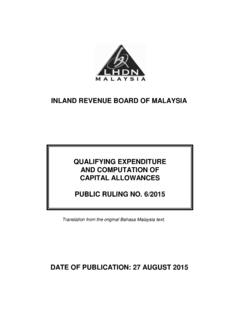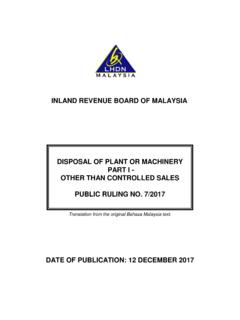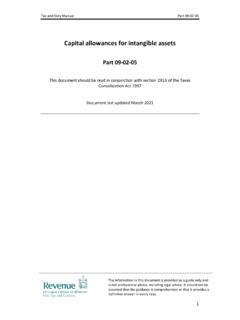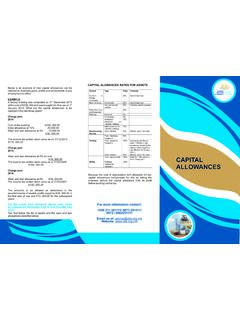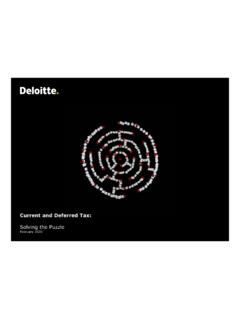Transcription of Capital allowances for structures and buildings - GOV.UK
1 1 Capital allowances for structures and buildings Technical Note 29 October 2018 Contents Introduction Chapter 1 Aim of the relief Chapter 2 Outline of relief Chapter 3 Key features of the SBA Chapter 4 Expenditure that will qualify for SBA or not Chapter 5 Timing and amount of relief available Chapter 6 Treatment for particular transactions Chapter 7 Chapter 8 Chapter 9 Chapter 10 Treatment for leasing transactions Anti-avoidance provisions Commencement conditions Next steps This technical note outlines a new Capital allowance for structures and buildings from 29 October 2018. It provides businesses with information before draft legislation is published in Finance Bill 2018-19.
2 2 Introduction 1. The Chancellor announced at Budget 2018 that the government will introduce a new structures and buildings allowance (SBA) for new non-residential structures and buildings . Relief will be provided on eligible construction costs incurred on or after 29 October 2018, at an annual rate of two percent on a straight-line basis. 2. This will improve the UK s international competitiveness. The UK currently has the lowest Corporation Tax rate in the G20 which is set to decrease further to 17% in 2020 as well as generous tax relief for research and development to support innovation. The SBA will further reduce the costs of doing business in the UK.
3 3. This SBA directly addresses a gap in the current Capital allowances system, where no relief has been available for most structures and buildings , although Capital allowances are available for plant and machinery that forms integral features of buildings , such as air conditioning. It is a longstanding request from business representative groups that Capital investment to construct structures and buildings should be relieved, as is already the case for other types of investment. The Office of Tax Simplification recommended widening the current scope of Capital allowances in their report earlier this The government recognises the issue, and is responding. The SBA will ensure that expenditure on new commercial structures and buildings will be generally relievable over time through the tax system.
4 4. The introduction of the SBA represents a long-term commitment to improving the competitiveness of the UK as a destination for investment. Businesses factor future Capital allowances into their investment decisions, and the SBA will improve the business case for new investments in structures and buildings . 5. Aspects of the design of the SBA that the government invites views on are underlined in this note and summarised in chapter 10. If you have any questions about this technical note, please contact our mailbox: Chapter 1 Aim of the relief 6. The aim of the SBA is to relieve the costs of physically constructing new structures and buildings .
5 This will encourage investment in the construction of new structures and buildings that are intended for commercial use, the necessary works to bring them into existence and the improvement of existing structures and buildings , including the cost of converting existing premises for use in a qualifying activity. These assets are already depreciated in many businesses accounts, but until now without tax relief being given on all the expenditure. 7. The SBA is intended to stimulate investment in structures and buildings that are intended for commercial activity. Neither land nor dwellings will be eligible for relief. Where there is mixed use - for example, between commercial and residential units in a 1 Accounting depreciation or Capital allowances ?
6 Simplifying tax reliefs for tangible fixed assets , June 2018. 3 development - relief will be reduced by apportionment. No relief will be provided for work spaces within domestic settings, such as home-offices. 8. Relief will be limited to the original cost of construction or renovation, relieved across a fixed 50-year period, regardless of ownership changes. Chapter 2 Outline of the relief 9. Businesses that incur qualifying Capital expenditure on structures or buildings used for qualifying activities will be able to claim the SBA over a 50 year period to encourage investment in the construction of new structures and buildings and the improvement of existing ones.
7 The SBA will be allowed as a deduction from profits at an annual rate of two percent. The relief will be available to businesses that chargeable to income tax and companies chargeable to corporation tax. 10. The two percent writing down allowance will be at a flat rate, calculated on the amount of original construction expenditure. There will not be a system of balancing charges or balancing allowances on a subsequent disposal of the asset. Instead, a purchaser will continue to claim the annual allowance of two percent of the original cost. This is intended to ensure that the cost of construction and renovation will be relieved over an average life of buildings . The amount eligible for relief will not be increased where a structure or building is purchased and where it has appreciated in value as this does not represent the cost of construction.
8 11. Relief will not be available for structures or buildings where a contract for the physical construction works is entered into before 29 October 2018 (see chapter 9). For speculative building and those structures or buildings constructed in house , relief will not be available where the construction activity began before 29 October 2018. 12. Anti-avoidance rules will apply to prevent manipulation of these rules. Chapter 3 Key features of the SBA 13. The chapters that follow provide more detail on these key features, principally that: a) relief will be given at a flat rate of two percent over a 50-year period b) relief will be available for new commercial structures and buildings , including costs for new conversions or renovations c) relief is available for UK and overseas structures and buildings , where the business is within the charge to UK tax d) relief will be limited to the costs of physically constructing the structure or building , including costs of demolition or land alterations necessary for construction, and direct costs required to bring the asset into existence e)
9 Relief is available for eligible expenditure incurred where all the contracts for the physical construction works were entered into on or after 29 October 2018 f) claims can only be made from when a structure or building first comes into use 4 g) land costs or rights over land will not be eligible for relief, nor will the costs of obtaining planning permission h) the claimant must have an interest in the land on which the structure or building is constructed i) dwelling houses will not qualify, nor any part of a building used as a dwelling where the remainder of the building is commercial j) sale of the asset will not result in a balancing adjustment - instead, the purchaser takes over the remainder of the allowances written down over the remaining part of the 50-year period k) expenditure on integral features and fittings of a structure or building that are currently allowable as expenditure on plant and machinery , will continue to qualify for writing down allowances for plant and machinery including the Annual Investment allowance (AIA) up to its annual limit l) SBA expenditure will not qualify for the AIA m)
10 Where a structure or building is renovated or converted so that it becomes a qualifying asset, the expenditure will qualify for a separate two percent relief over the next 50 years. Chapter 4 Expenditure that will qualify for SBA or not Qualifying expenditure 14. SBA will be available for Capital expenditure on structures and buildings brought into use for the following qualifying activities: a) a trade, including a ring-fence trade in the oil and gas sector b) a profession or vocation c) a UK or overseas property business that is an ordinary business for the purposes of the Capital allowances Act 2001 d) a concern listed in section 12(4) of the Income Tax (Trading and Other Income) Act 2005 or section 39(4) of the Corporation Tax Act 2009 (mines, transport undertakings etc.










